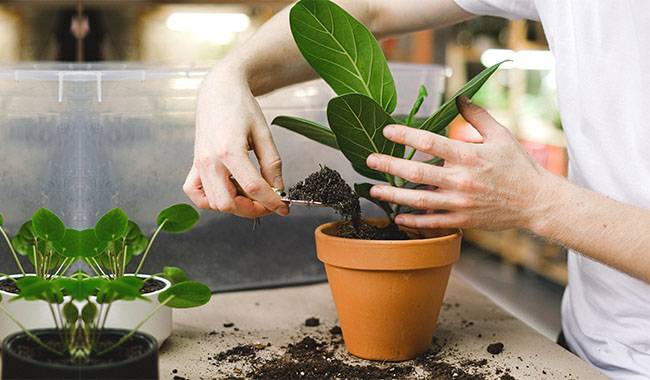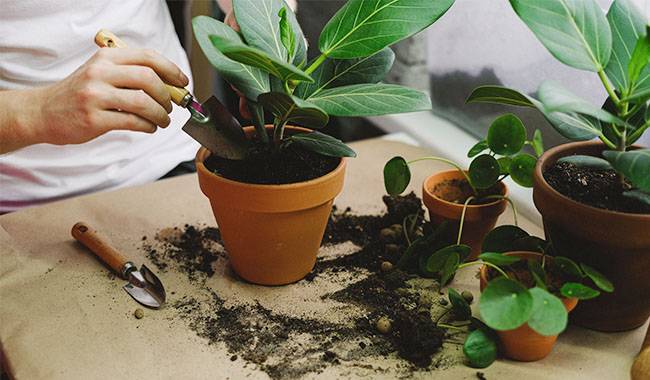
Among the various indoor plants, there are some real fighters. They are not afraid of irregular watering, shade, and sudden changes in temperature. That’s how I see Ficus cyathistipula (African fig), the ficus tree. I first saw it in the hallway outside our accounting office. 60 inches (1.5 meters) long, the beautiful plant with large oblong leaves won my heart. I love tall plants, both indoors and outdoors, so I couldn’t help but pass it by. I went into the office and asked our “ladies” for a scion. So I bought a ficus for the office and it quickly became a ficus for the house. You will learn The Reason Why Ficus Cyathistipula Plant Not Growing in the ThumbGarden article.
Characteristics Of Ficus Cyathistipula Growth And Development
In a spacious pot with minimal care, Ficus cyathistipula can grow up to 80 inches (2 meters) in the house. It is often found in offices, public buildings, and clinics. It grows successfully without any special care and is remarkably tolerant of negligent owners who forget to water or feed it.
Ficus cyathistipula is thought to be native to tropical Angola, Zambia, and Tanzania. There, in the generous tropical sunshine over vast expanses of land, Ficus cyathistipula grows to 25-33 inches (7-10 m). The canopy becomes spreading and shady, and the fruit is edible but not particularly flavorful, maturing over time.
At home, it is relatively moderate in size, with branches that do not spread as widely from the trunk. Like its wild counterpart, it retains a light brown bark that is oval in shape but requires occasional pruning to maintain the desired contours.
The bicolor leaves of this ficus are very beautiful. They have a dark green exterior with a clearly visible network of veins, and a lighter underside with raised cuttings.
When I started growing my own ficus, I realized that it is indeed a very tough plant, but it also has an Achilles’ heel.
Ficus Cyathistipula Plant Requirements For Conditions And Care

Ficus cyathistipula is native to the tropics, so in honor of its homeland, it retains a fondness for daily moisture. Living in a humid environment is uncomfortable for humans. To find a compromise, simply place a sprayer near the pot and spray the foliage daily with warm, tempered water.
A. Temperature range and habitat
Ficus can easily tolerate a difference of 46-50 °F (8-10°C). In the summer, temperatures are a comfortable 73-80 °F (23-27°C). In the cooler months, it easily tolerates 59-64 °F (15-18°C). It is a favorite of office technicians. During colder months, it easily tolerates 59-64 °F (15-18°C), which is why it’s a favorite of office technicians. It doesn’t need to be permanently tucked away in a warm corner during seasonal heating cuts.
Not only that, but Ficus cyathistipula is so persistent about moving that it sheds most of its leaves, turns into a bare palm, and drastically stops growing. I was a bit taken aback when I saw my pet in this state at my accountant’s office. It turned out that the container containing the flowers had been moved to another window, in addition to a vent. It turned out to be such a misunderstanding.
I have also moved Ficus cyathistipula from one room to another in my house without such catastrophic consequences. The problem is that my windows are in the same direction. It seems to me that the Ficus cyathistipula doesn’t even notice the difference, but continues to enjoy its dense foliage.
B. Watering
During the warmer months, it is best to water Ficus cyathistipula regularly, twice a week. In September, gradually increase the interval to once every 7 days.
To prevent root rot, sometimes a “drying period” is necessary until the root ball is completely dry. You should also avoid leaving water in the tray. If water is still present 20-30 minutes after watering, be sure to drain the water or pick it up with a sponge (if the plant is already large and difficult to lift).
C. Light
The amount of sunlight is not important for ficus. It will do very well in the eastern or western part of the room with a slight amount of diffused light. It should not be deprived of light at all; the trunk will begin to elongate and distort, and the leaves will shrivel and lose their rich color. However, where most houseplants begin to wilt, the ficus grows normally and shows no signs of dissatisfaction.
If you choose a corner that does not benefit from natural light at all, you can install a small artificial light source, such as an LED or sodium plant light with an original design. Not only is it beneficial to the plants, but it also performs an aesthetic task. This is how I solved the lighting problem of some plants in my house.
D. Fertilization
It is important that you do this regularly. If the plant is completely neglected and no external nutrients are added, the Ficus cyathistipula will stop growing once it uses up the nutrients in the soil mixture. On average, it will gain 8-10 inches (20-25 cm) per year, adding 1-2 inches (2.5-5 cm) to its root system. Fertilizing every 14-20 days is sufficient for normal development and to maintain the decorative appearance of the plant.
I alternate between organic and mineral fertilizers. Since we have a summer house, it is easy for me to bring a cup of wood ash. I make an ash solution at a rate of 1 cup per bucket and spread it to most plants every 2 months.
My ficus also loves succinic acid. After feeding, it produces new leaves with brighter colors. Feed once a month with a solution of 1 tablet per 0.26 gals (1 liter) of water. It can be watered and sprayed without any harm.
You can also use Ficus cyathistipula as an organic fertilizer.
- Compost.
- Yeast.
- Nettle infusion.
- Brewed tea.
- Coffee grounds.
The residues of tea and coffee must always be incorporated into the soil. Left on the surface, they quickly go moldy.
Among mineral fertilizers, I choose REASIL, Agricola, etc. They have a balanced content of nitrogen, potassium, phosphorus, calcium, and iron. The liquid types are very convenient; dilute according to the instructions and apply after irrigation. The granular form is designed to last longer and is used in the summer.
I’ve also heard of stick fertilizers that you just stick in the soil and let it slowly melt as you water, but I haven’t seen them in stores. It will be interesting to try them out. Intensive fertilization ends in the fall and the plants go dormant until the end of February.
E. Transplantation
During the first few years, the Ficus cyathistipula grows rapidly and needs to be replaced with a larger pot each year. Every year the diameter of the pot increases by 2 inches (5 cm). If the pot becomes too small, it becomes stunted, underdeveloped and growth is neglected. Its lifestyle is similar to that of aquarium turtles, whose shells are sized to match the area of the aquarium bottom.
Transplanting is complete when the container reaches 14-16 inches (35-40 cm) in diameter. Instead, some soil was replaced with new soil in early spring without touching the roots.
The soil mixture for Ficus cyathistipula consists of equal parts peat, humus, and sand. Sometimes I add turf soil. A drainage layer is necessary to allow air circulation and to prevent waterlogging of the roots.
More Related: How to Take Care for Ficus Plant
Causes Of Cessation Of Growth In Ficus Cyathistipula

In nature, the leaves of Ficus cyathistipula are considered to be long-lived and can easily live up to 400 years. The lifespan of indoor plants is about 15 years. Intense growth occurs in the first 4-5 years, then it will only stretch a few inches per year.
If your Ficus cyathistipula has stopped growing, it has reached its height limit, or it is desperately lacking in something. This species pays little or no attention to the little things. However, the plant will stop growing in the following cases
- The pot becomes small, depressing the root system.
- There is not enough fertilizer.
- There is not enough light.
- The plant is sick or infested with pests.
How Can I Help The Plant?
After observing my Ficus cyathistipula for several years, I found that simple techniques help stimulate growth.
- Repot in larger pots every year until the plant is fully grown.
- Fertilize regularly from spring to fall, alternating between mineral and organic fertilizers.
- Spray the leaves of the plant with warm water to give it a shower of contrast.
- Apply preventive pest control treatments twice a year.
- Make sure there is adequate lighting.
Ficus cyathistipula does not need anything else to have a happy life and blooming appearance.
Typical Mistakes When Planting Ficus Cyathistipula
Ficus cyathistipula has some weaknesses that must be taken into account when planting. It is fearful of draughts and responds by defoliating and weakening its immunity.
The plant can tolerate occasional overwatering, but if overwatering becomes a regular occurrence, the roots will quickly begin to rot. It is safer to leave the ficus in a water-starved state.
There should not be complete shade where it grows. The leaves should get at least some light, even if it is sporadic, during the first half or second half of the day.
I have a ficus tree on the east side of the room that makes way for a sunny windowsill for Ficus cyathistipula. It is watered on a schedule. It receives a feed every 2 weeks and is clearly ready to share a cutting for a neighbor who has been eyeing my beauty for a long time.







